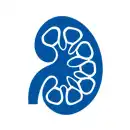
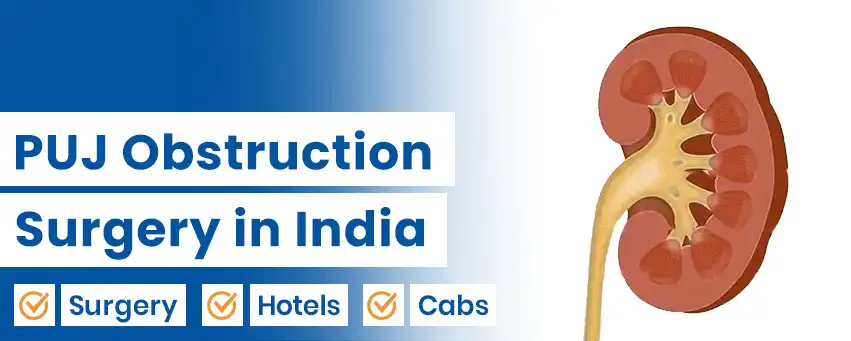
PUJ obstruction is a urinary condition that is characterised by a blockage and narrowing where the ureter meets the renal pelvis. This leads to reduced urine flow and impair kidney function. If left untreated, it can affect urinary health and kidney performance. Recognising the symptoms early and understanding available treatment options can help manage this condition.
India is a preferred country for African patients needing PUJ obstruction surgery due to the country's experienced urologists, advanced medical technology, affordable treatment costs, and quality healthcare services. With personalised care, minimal waiting times, and comprehensive international support, it is also a leading country for PUJ obstruction surgery in India.
This page will be an international patient's guide to availing PUJ obstruction surgery in India, including its costs, top PUJ obstruction hospitals and the available surgical treatments in India.
PUJ obstruction, or pelvic-ureteric junction obstruction, is a urologic condition. It includes a blockage at the intersection where the renal pelvis meets the ureter, blocking the pee stream. This condition can prompt kidney enlarging and weakened kidney capacity.
.webp)
Careful interventions are expected for PUJ obstructions. They aim to reduce the blockage and restore the normal urinary flow. Early detection and proper clinical intervention are critical for managing PUJ blocks. They help prevent problems, such as kidney damage.
PUJ obstruction pain represents a huge concern. Diagnosing this is essential for managing related pain. It ensures optimal kidney function. The cycle includes a few fundamental stages.
Doctors start by assessing side effects, zeroing in on PUJ check-related torment. Knowing the nature and power of the aggravation supports the beginning conclusion.
Radiological examinations, such as ultrasound, are essential. CT scans also play a critical role in the diagnostic process. These imaging procedures provide a detailed view of the urinary tract. They highlight potential obstructions.
Urodynamic studies are utilized to survey the urinary stream and tension. These tests assist with deciding the effect of PUJ impediment on, by and large, kidney capability.
A cystoscope, a slender tube with a camera, is inserted through the urethra. It visualises the PUJ region. This guides in denoting any physical anomalies adding to the condition.
MRU offers a painless procedure. It provides detailed images of the urinary tract. It helps evaluate the life systems and work of the PUJ.
Understanding the main causes of PUJ obstructions is crucial for precise diagnoses and personalised treatment. Surgical intervention is be needed to relieve the blockage and restore normal urinary function:
.webp)
PUJ obstruction often arises from intrinsic anomalies. Individuals are born with inherent irregularities in the renal pelvis or ureter. These oddities thwart the smooth section of pee.
Over time, scarring and fibrosis can develop in the PUJ region. This can result from inflammation, infections, or previous surgical interventions. These underlying changes lead to a limiting of the intersection, causing obstacles.
The formation of kidney stones can obstruct the PUJ. This disrupts the flow of urine from the renal pelvis to the ureter. These stones may form because of different elements, including dryness and dietary propensities.
Strange developments, growths, and masses close to the PUJ can hinder the pee stream. These developments may be harmless or dangerous and require brief clinical consideration.
Persistent inflammatory conditions can result in a PUJ obstruction. Such conditions include recurrent infections or autoimmune issues. Aggravation can prompt tissue harm and scarring, adding to the blockage.
Recognising the diverse symptoms that are linked to PUJ obstruction is important. Whether on the left side, in mild cases, or when partial, early intervention is enabled. Timely clinical assessment is crucial. Appropriate management is essential for preserving renal function and enhancing the patient's well-being.
.webp)
Left PUJ obstruction appears through tenacious flank torment and distress. Urinary diseases (UTIs) may become repetitive, joined by hematuria. In extreme cases, hydronephrosis is created, prompting moderate renal harm. Early diagnosis helps prevent bothering.
Mild PUJ obstruction may exhibit irregular flank pain during hydration or exercise. Patients could encounter ambiguous uneasiness as opposed to extreme agony. Hematuria and UTIs might happen irregularly. Observing side effects and normal check-ups are prescribed to evaluate movement.
Partial PUJ obstruction can cause sporadic, colicky pain in the affected flank. Gentle hydronephrosis may be detected in imaging studies. Patients could see changes in pee tone because of hematuria. Brief clinical consideration is important to anticipate decay.
Surgical approaches for PUJ obstruction in newborn treatment involve traditional open surgeries. They also encompass modern minimally invasive techniques. Each approach expects to lighten the block proficiently, guaranteeing the prosperity of the infant patient.
.webp)
An open PUJ obstruction surgery stays a customary yet successful procedure for PUJ check therapy. This technique includes an immediate cut. It allows specialists to access and fix the discouraged junction. The open, careful procedure ensures accuracy. It is reasonable for complex cases.
Minimally invasive procedures have altered PUJ obstacle treatment for infants. These systems offer reduced pain and a short-term healing period. The systems include laparoscopic and mechanical medical procedures. Little invasive strategies include little entry points, limiting injury to surrounding tissues. They give an improved representation of the impacted region, helping with the exact revision of the PUJ block.
A PUJ obstruction can impair urine flow, harm kidney function, and cause pain and recurring infections. Thankfully, India has highly experienced urologists and reconstructive surgeons who specialise in diagnosing and treating PUJ obstruction using procedures like laparoscopic or robotic Pyeloplasty. Here are our top doctors for PUJ obstruction treatment in India:
Dr. Gautam Banga is a reputed urologist and reconstructive surgeon in India with specialisation in urinary tract disorders, including PUJ obstruction. He offers advanced treatment care, including minimally invasive surgeries such as laparoscopic and robotic‑assisted pyeloplasty with less postoperative pain, shorter hospital stays, and swift recovery.
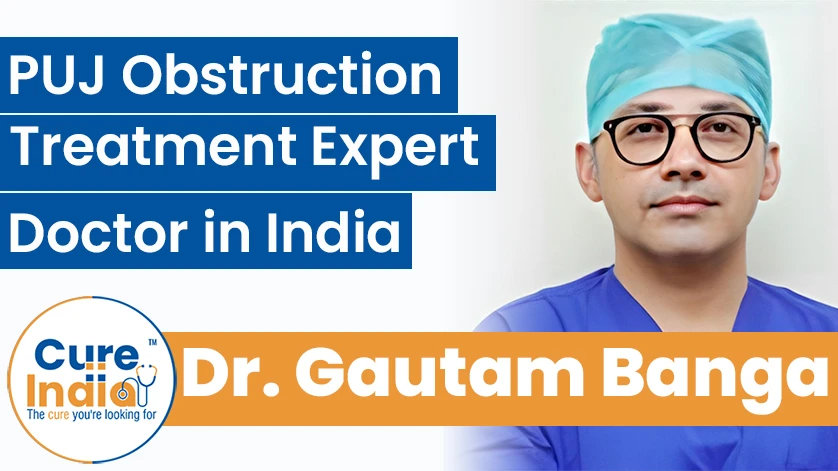
Dr. Vijayant Govinda Gupta brings extensive urological expertise of over 17 years to the management of PUJ obstruction with both surgical and minimally invasive treatment options. He is adept at performing reconstructive procedures that aim to restore urine flow from the kidneys to the bladder, all while minimising complications such as hydronephrosis and recurrent urinary infections.
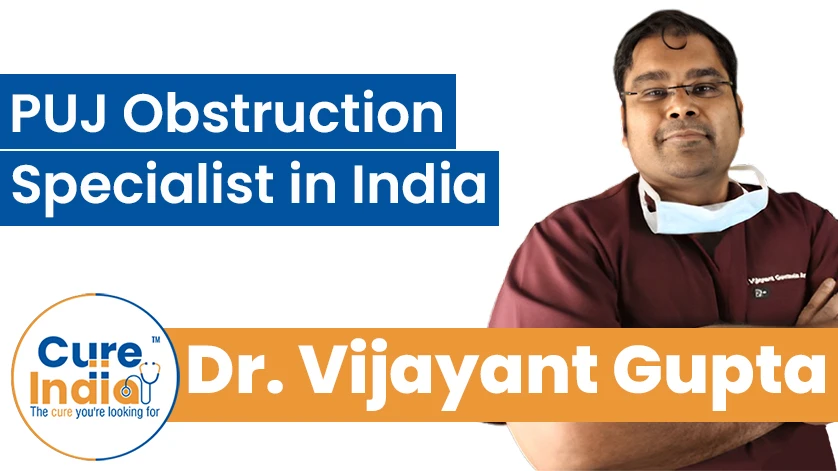
Dr. Shalabh Agarwal is a top PUJ Obstruction specalist in India who is known for his expertise in urological reconstruction and renal drainage disorders, including PUJ obstruction. He offers advanced surgical treatments and procedures, including reconstructive pyeloplasty for both congenital and acquired PUJ obstruction.

Dr. Anant Kumar is a leading urology surgeon in India, specialising in the diagnosis and surgical management of PUJ obstruction. With experience of around 35 years in reconstructive urology such as urethroplasty procedures, he brings to patients knowledge and expertise in both open and minimally invasive surgical procedures, with successful results and success rates.

The cost of surgery for PUJ obstruction in India varies depending on hospital, technique (open / laparoscopic / robotic), and associated factors. The average cost of PUJ obstruction surgery in India ranges around $3,200. In some hospitals costs may go higher depending on complexity, hospital standards, and postoperative care. Here is a table mentioning the average cost of PUJ obstruction surgery in India along with a patient’s total stay:
| Treatment Name | Cost in India | Stay in India |
|---|---|---|
| PUJ Obstruction Surgery in India | $3,200 - $3,500 | 7 Days |
PUJ (Pelvic - Ureteric Junction) surgery is a crucial technique for tending to kidney stone-related issues. This medical procedure includes eliminating calculi, or stones. These stones impede the progression of pee from the kidney to the bladder. The groundwork for PUJ calculus surgery is significant for guaranteeing a fruitful strategy.
Before the PUJ medical procedure, a thorough clinical evaluation is conducted. It assesses the patient's overall health and identifies any potential difficulties.
It uses high-level imaging techniques, such as CT scans or ultrasound. They precisely locate and assess the size and composition of the kidney stones causing the obstruction.
In many cases, doctors recommend medicative prescriptions to patients. This is to oversee torment, forestall contamination, and work with smoother, careful results.
Clear communication between medical services suppliers and patients is essential. Patients receive information about the surgery, expected outcomes, and postoperative care. It ensures informed, independent guidance.
A multidisciplinary team collaborates to facilitate the surgery effectively. This team includes urologists, anesthesiologists, and nurses. It ensures an improved patient safety and speedy recovery.
PUJ obstruction surgery is a crucial procedure. It manages blockages in the connection between the renal pelvis and ureter. The recovery cycle plays an urgent part in ensuring ideal results for patients. The following are five chief pieces of PUJ deterrent medical procedure rehab:
In the immediate aftermath of PUJ block surgery, meticulous attention is essential. Patients will be closely monitored in a recovery room. Medical professionals will assess vital signs and pain levels. Adequate pain management and the administration of prescribed medications characterize this initial stage. It promotes comfort and stability.
One crucial aspect of PUJ check surgery recovery involves monitoring drainage and urinary function. This includes noticing the benefit of any embedded stents or channels. Regular check-ups help identify and address any difficulties promptly. This ensures the smooth flow of urine and prevents potential issues.
Continuous reintegration of actual work is required for fruitful healing. Patients are urged to take part in light actions and activities. Actual restoration may be guided to restore strength and flexibility. It is tailored for individual recovery progress.
Proper nutrition and hydration are essential elements of PUJ obstruction surgery recovery. After surgery, dietary guidelines may be provided to aid recovery and prevent complications. Sufficient hydration supports flushing out poisons and keeping up with general kidney well-being.
Booked follow-up meetings with medical care suppliers are vital for observing long-haul recovery progress. Imaging studies, such as ultrasounds or CT examinations, may be conducted. They assess the surgical site and ensure the resolution of the PUJ obstruction. These discussions offer chances to address any arising concerns and improve progressing care.
In conclusion, tending to the PUJ check through careful mediation gives huge help. The PUJ obstruction operation resolves urinary flow issues. It promotes improved kidney function. Mitigating the blockage reduces long-haul intricacies and related side effects. This method limits irregular corrosion. This ensures supported urinary parcel well-being. Choosing PUJ to check a medical procedure yields substantial advantages. It adds to work on personal satisfaction and, by and large, prosperity.


Suffering from Erectile Dysfunction
Open up and get treated
Semi Rigid and Inflatable Penile Implants
Get back the Erection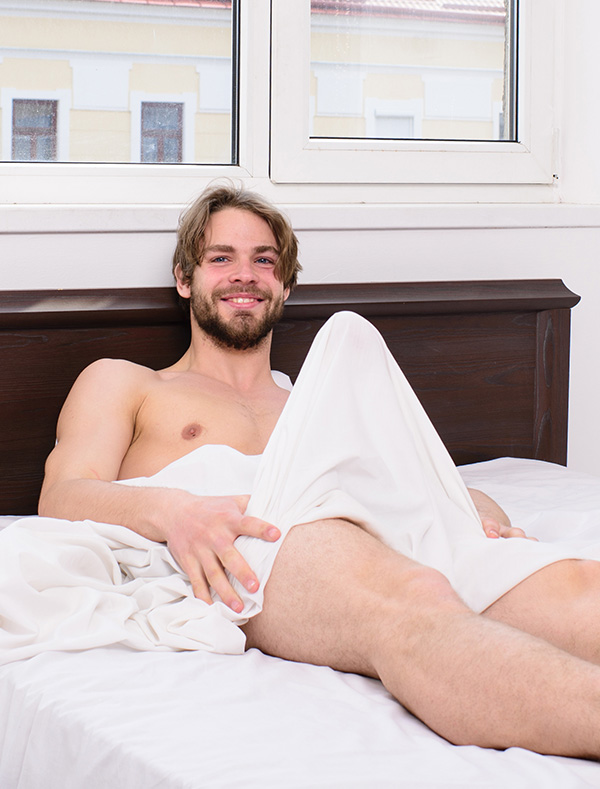
Insecure about your size
Get Penile Augmentation